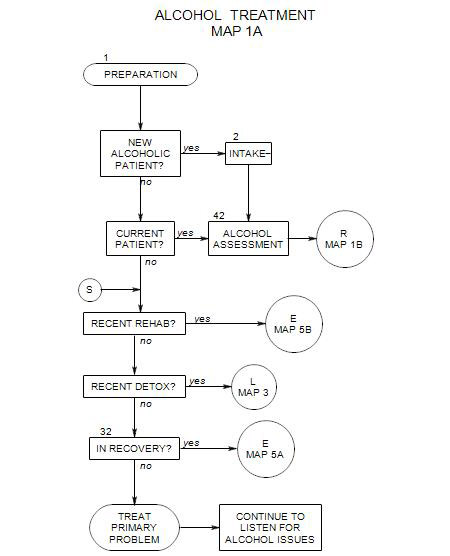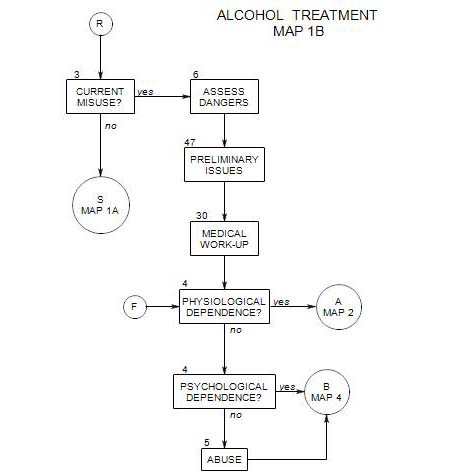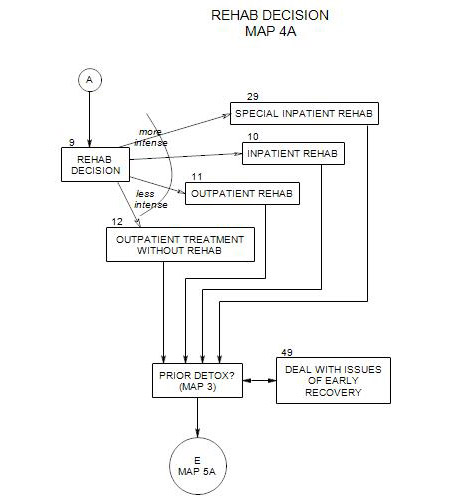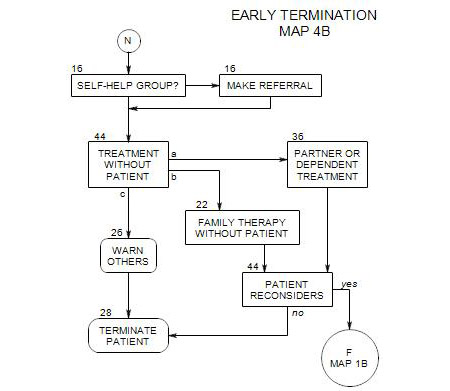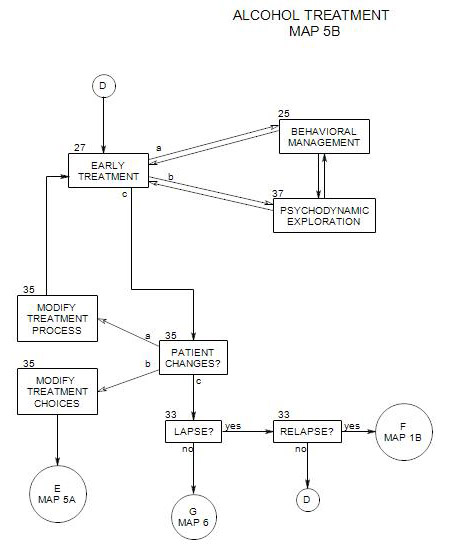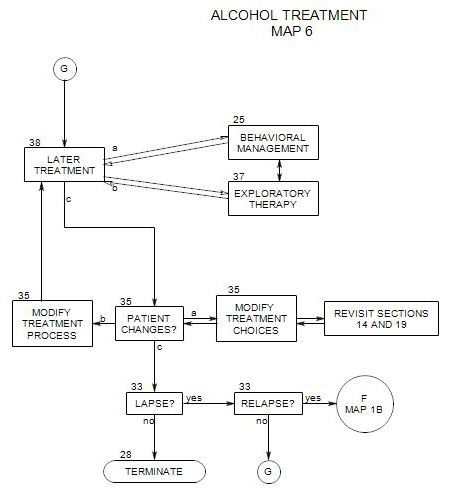36. TREAT THE PATIENT’S PARTNER OR DEPENDENT
- This section is associated with Section 19 [Adjunctive Care Decision] on Map 5 and with Section 22 [Family Therapy] and Section 17 [Couple Therapy]. However, the issue can become relevant at any time.
Anyone who lives with an alcoholic person participates in the alcoholic’s disorder in some way. Other family members may –
- contribute to the stresses that propel the patient to drink.
- need to deal with the consequences of the patient’s drinking.
- need therapy for their own drinking or other psychological issues.
Treatment of other family members cannot be independent of their impact on the identified patient. Whether others are considered adjunctive care or separate patients is often a function of the attitudes of the participants – including the therapist. But attitudes can also be managed, and a family member who starts out only helping the identified patient may discover other issues that need to be addressed. At the same time, when dealing with another family member in his/her own therapy, it pays to keep the possible impact on the original identified patient in mind.
This section will consider some of the issues of individual family members and their treatment. However, treatment of other family members can be considered a subtype of family therapy. Section 22 will consider issues of working with the family as a unit and Section 17 with working with the identified patient as a member of a couple. For other treatments of this topic, See Zelvin (2004) and Perkinson (2002). .
36a. Adult Partners or Dependents
There are many occasions when it can be helpful to recommend treatment for the patient’s partner or adult dependent.
- As a form of adjunctive treatment for an alcoholic patient. In this case, having the partner or one or more dependents in therapy can facilitate treatment for the patient as well as help the others deal with the patient and any changes he/she may be going through.
- As a fallback treatment if the identified patient stops therapy. In this case, therapy for the partner or dependent can help that person cope with the alcoholic’s continued drinking and possibly provide ongoing pressure for him/her to stop drinking and to return to treatment.
36b. Some Typical Issues
Other family members can have a wide range of issues, but they also tend to have some things in common because of their connection to an alcohol misuser. This section will focus on the partner of the identified patient, but many of the same issues can apply to others as well.
Substance use
An alcoholic’s partner may also be an alcoholic or may have another addiction, possibly marijuana, sweets or anxiety medications. It is important to ask about use of alcohol and other drugs, and the questions can reasonably be presented as routine. You can also ask about the partner’s eating patterns, and any drugs that he/she may need in order to cope with moods or to get to sleep. Changing substance-related coping mechanisms can either be a goal of treatment [if you work to change it directly] or an indicator of treatment effectiveness.
Attitude to the Identified Patient
Partners are likely to be angry, self-righteous, impatient, rigid, controlling, or critical of the identified patient. They may blame the alcoholic and his/her drinking for causing all the personal upset and family dysfunction that they are experiencing. Their attitude may take the form of overly simple solutions that the alcoholic isn’t likely to use, e.g.: “All he has to do is stay away from the bars.”
Others may also fear the identified patient, if drinking leads to anger, recklessness or violence. This is especially likely for the children of a violent alcoholic, who often believe that they have no recourse or place of safety in the family, and that attempts to go to outside resources will be ineffective and treated as betrayal by the violent family member.
“I took care of everything the best I could. I knew that if he had been drinking, he would find something to be angry about. Mom was working, and the house was my responsibility. The other kids were too small. I would get them into their rooms and wait for him in the kitchen. There was no point to hiding; he could always find me and it would be worse.”
It is possible that the partner is looking for an opportunity to leave the relationship – in fact, may already have made steps to do so that haven’t been revealed to the identified patient, the therapist, or the rest of the family yet. The start of treatment or the beginning of changes may be taken by the partner as an indicator that it’s time to go.
Secrecy
There can be many forms of secrecy in the family of an alcoholic, including..
- attempts to hide family issues such as the patient’s drinking from the outside world.
- attempts to manage information within the family, possibly to protect self or other family members from the identified patient, or from others who are disruptive, critical or violent.
- withdrawal of some family members from contact with others in the family, through self-protection, superiority and judgments of others, or just needing to move on. This may be an effective defense from the patient’s behavior, but it also can make the withdrawn person less available for treatment.
- shame, and the need to appear normal while at the same time thinking that something is wrong with them or their family, and that the alcoholic is only a part of that wrongness.
Self Concept
The partner may be blame-avoidant, with no sense of a need to change. Partners often see themselves as victimized by the alcoholic’s drinking and associated behavior. They believe that they have already tried everything possible, to deal with the drinking. They may think that they are sensitive, perceptive, self-aware, and if anything, overly tolerant of the identified patient’s obvious shortcomings. They see themselves as picking up the pieces that the identified patient has dropped. They may lack sympathy for the identified patient, who after all is the source of all the problems in the family. Outsiders may see the partner as a saint, martyred to the alcoholic’s drinking and misbehavior.
On the other hand, blaming the alcoholic may be a defense against guilt for their own part in family dysfunction. Partners may even blame themselves for all that is wrong with the identified patient and the family. They may also be ashamed: something is terribly wrong with them for having caused “all this”, or even for being a part of such a dysfunctional family. This can be one basis for the secrecy so often found in alcoholic families.
Wives of alcoholic men may also be blamed by others for their husbands’ drinking “She drove him to drink” or other failures as spouses. They may come to believe that if they were better partners, the alcoholic wouldn’t need to drink or be abusive. This can lead to endless attempts to improve without ever being appreciated for themselves or their efforts These people tend to codependency as they endlessly strive to help the alcoholic and repair damages in the family.
Need to Control
Partners tend to see their controlling behavior as self-defensive. Outsiders may see their need to control as a character defect; they see as focused and situationally necessary. The identified patient is out of control, and they control as much as they can as a matter of protection of self, alcoholic, and other family members.
Enabling
This term refers to a variety of ways that the partner inadvertently perpetuates the patient’s alcohol use. It may begin with excuses for the alcoholic’s drinking and bad behavior and develop into active attempts to deal with him/her. Enablers are over-responsible – they manage everything else in the family in spite of the alcoholic’s misuse. They make excuses with family, friends and employers. They may be so effective that people outside the family are unaware that there is a problem.
The partner may deny that the alcoholic is drinking, or minimize it, or deny that it’s a problem, that it is a cause of other problems, or that it has anything to do with problems in the family. This enables the alcoholic to continue to drink without accepting any blame for drinking or its consequences.
Commonly, the enabler’s goal is not to make it easier for the alcoholic to get drunk, but rather to protect him/her from the negative consequences of drinking.
Howard is due home for dinner at 6:30. At 6:30, dinner is ready to be served, and Betty and the kids are sitting at the table. Howard is late. By 7:30, the kids are hungry, squirming, and irritable. Howard arrives at 8:00, drunk. Dinner is served. Howard passes out, face down in his roast beef and mashed potatoes, which follow him to the floor as he slides out of his chair. While the kids finish eating, Betty cleans up his mess, undresses him, drags him to bed and tucks him in. The next morning, he wakes with a hangover [which he perceives as normal] and no other evidence of a problem.
However, the alcoholic’s drinking may still be unacceptable to the other person. This presents a dilemma: how do you protect an alcoholic from the consequences of his/her behavior while attempting at the same time to get him/her to change? Partners try a variety of techniques to persuade an alcoholic to drink less, to drink responsibly, to stop drinking, or just to attend AA meetings. They pour out the alcoholic’s supply, find out about treatment programs, or enlist the help of professionals. They mark the sides of bottles to keep track of the amounts drunk. These attempts to manage the drinker are typically ineffective. At the same time, the partner is seen as oppressively controlling by the alcoholic, and avoided, ridiculed, fought, or ignored.
The effort to keep things running smoothly may become too much, leading the partner to be angry at the alcoholic, while at the same time proud of his/her own ability to cope in the face of such adversity. This characteristic may develop over time, as the alcoholic tends increasingly to take care of his/her own impulses and perceived needs, and the partner does everything else, including taking over many of the alcoholic’s responsibilities.
Codependency
We say that an alcoholic’s partner is codependent when he/she becomes so caught up in the relationship with the identified patient that he/she appears to have no independent existence. It is possible to see co-dependency as an extreme form of enabling, the end of a spiral in which the partner becomes more and more involved in managing, controlling, protecting and caring for the alcoholic over time.
Because they focus their lives on the alcoholic person, codependent partners have no time for their own needs. They are always doing more, hoping to manage everything. They tend to suppress their own feelings, keep secrets, and never ask for what they want. In fact, they may become so focused on the identified patient and his/her needs that they lose the inability to know what they feel. [“So, Betty, what was your reaction to that?” “Well, Howard thinks that they -“]
Codependent partners keep trying to manage everything, but things keep getting worse, leading to feelings of inadequacy and uncertainty They have lost their sense of independent identity and replaced it with an exaggerated dependence on the loved object.
They may also be controlling, inflexible, perfectionistic, and over-responsible. These traits may even be ego-syntonic within their relationship with the alcoholic, who is often irresponsible, who must be controlled, and who seeks opportunity in every lapse in the codependent’s rigidity.
At the same time, extreme dependency is itself an uncertain position to be in, and the unreliability and self-serving behaviors of alcoholics make them in many ways unsafe people to be dependent upon. Codependents tend to exhibit low self esteem, chronic anxiety and/or depression, possibly because of the role they have chosen or their attachment objects.
However, not every enabler follows this path into codependency, and there may be a question of which came first: hyper-involvement with the identified patient or a strong need to find someone to attach to and take care of. Evidence about this issue can come from the person’s other relationships, exploration of which can sometimes lead the codependent partner into his/her own treatment. Perkinson (2002: 357-363) provides a checklist of codependent behaviors that can be given to partners as homework or used as an interview guide.
People who are generally co-dependent are “people-pleasers”: nurturing, with an acute need for approval, a fear of abandonment, an inability to express anger, and a fear of risk taking. If a codependent person finds treatment, these qualities should be addressed eventually.
36c. Who Should Treat
Partners and dependents can be seen with the IP, separately, or in some combination of individual, couple or family work.
There often arises the question of whether the same therapist should be treating both the identified patient and any partner or dependent. Advantages of using the same therapist include
- The therapist has a clearer picture of the overall situation, because information comes from more than one participant in family affairs.
- The therapist may be able to choreograph some of the relationship moves that need to be made for the increased psychological health of all family members
On the negative side,
- There is always a risk that the therapist will be seen as biased by the patient or the partner, potentially interfering with treatment effectiveness. This risk is greater when the therapist has an individual relationship with one and not the other.
- If the partners split or one leaves the family, there may be a difficulty for the same therapist to continue working with all participants.
- If the patient leaves treatment and the therapist switches to another family member, it may feel disloyal to the original patient, who may not be able to return to the therapist – or to any other therapist.
36d. Making the Contact
If a patient has previously been in rehabilitation, it is not unusual for families to be engaged in the treatment. In this case, there is a basis for continuing with that format; or the patient may have already developed firm resistance to it. A typical procedure is to ask about the rehab process, and follow up with interest in the partner’s input to treatment.
It is also possible that you have met the partner before, during the intake process. In this case, it might seem natural for you to invite him/her back for more information or a different perspective.
In general, it pays to get the partner’s perspective. This is especially true in dealing with alcoholic patients, who are or have been out of control of their own lives, and who often are lacking in self-awareness.
Identified patient must be aware of the contact, else your credibility risks undermining from feelings of deception and manipulation. This is a particular problem with alcoholics, who often are concerned about being controlled. Any move that doesn’t involve their participation can be an incentive to leave therapy. This doesn’t necessarily mean that you need the permission of the identified patient if you are convinced that the contact is necessary. But you may need to weigh the pros and cons if he/she refuses or objects.
One path is to ask of the partner wants or needs treatment. An alcoholic may blame his/her partner and be very willing to include him/her.
Consider having the identified patient and partner in together first. This can relieve some conspiracy fantasies on the part of the identified patient, while at the same time easing the partner into what is sometimes anticipated as a hostile setting.
Warn the identified patient that you may be different in a couple setting. Decide together who should contact the partner; and schedule a time that is convenient for all three of you.
Engage the partner or dependent through helping the identified patient or helping the family deal with the IP.
36e. Some Treatment Suggestions
Initial Sessions
If the identified patient and partner come in together, the first order of business is to get comfortable. As part of that process, you can gather some information from the partner about the patient’s drinking, their relationship, the rest of the family, and recent events.
This process gives information about whether to proceed with couple therapy, or to treat the patient and partner separately, or to have the partner come in infrequently or on special occasions as needed. If they seem to see drinking and other issues as shared problems, couple therapy may provide them with interpersonal tools to work more effectively together. If they are antagonistic and unable to listen to each other, couple work may best be postponed.
The partner may not want to go for his/her own psychotherapy, on grounds that he/she isn’t the problem. There may be some truth to this idea, but it is commonly too simple and most likely defensive. Among other things, the partner may be contributing directly or indirectly to the identified patient’s problem, reacting to him/her, or avoiding issues that need to be dealt with.
The partner may also come alone initially for a variety of reasons In either case, the partner almost always begins as adjunctive to the alcoholic’s treatment. The question to keep in mind is whether he/she should continue in that role or go into his/her own therapy.
It may be difficult getting the other person involved. It is common for partners to deny that there is a problem, to refuse to participate on grounds that it is the identified patient’s issue, to be finished trying, having tried everything already. These excuses can sometimes be countered with the idea that the therapist is gathering information in order to work more effectively with the identified patient. The partner can help with that, and possibly with the identified patient’s treatment as well. Over time, there can be a transition to other issues as they come up.
Self-help group participation is often helpful to the families of alcoholic patients. If the partner or child is alcoholic, AA may be a good recommendation. If not, Al-Anon or Al-a-Teen are often helpful for family members. Group participation can stir up issues, help the partner separate from the identified patient, and force the identified patient to face him/herself in new ways. However, the common practice of just sending the partner or dependent to a self-help group may benefit the patient in some ways but not in itself be sufficient to address the partner’s needs.
Working with the partner
Over time, work with the partner may remain adjunctive to the patient’s treatment, with the partner providing information about the family and feedback about changes in the patient, helping manage the patient’s therapy, or disengaging from involvement in ways that benefit the patient. One basic goal in this case is to help the partner be more accepting of the patient and tolerant of the amount of time it takes the patient to make necessary changes.
If the partner is alcoholic and willing to work on it, start at the beginning: do at least an informal intake, check for the kind of alcohol misuse, etc. If the partner is unwilling to look at his/her own drinking, you still can ask what he/she is willing to do – if anything – to support the patient’s sobriety.
A drinking couple were going through a rough marital time when the wife had a drunk driving episode and ended up in detox and rehab. When she returned home, her husband was waiting for her, with dinner and drinks. She promptly relapsed and had to return to rehab. He wasn’t sympathetic.
If the partner is enabling the alcoholic’s addiction, this might be a good place to start. “Was it your intention to tempt Betty? What did you expect to happen when she came home and found a vodka bottle and two glasses set out to celebrate?”
If the partner is co-dependent, his/her personal issues will eventually need to be addressed. However, it generally pays to focus on enabling behavior first – both because it is easier to change and because it may be all that the partner will consider. If he/she can’t stop enabling, it will seem more natural to explore other issues.
If a codependent person becomes a patient, his/her individual issues can be treated, whatever they may be. Common issues include –
- excessive or destructive anger or criticism;
- difficulty expressing anger;
- strong need for approval;
- fear of abandonment; or
- difficulty expressing his/her own needs or point of view.
Regardless of the specific issues that the partner needs to address, you can start with Map 5: gather treatment data, decide on primary form of treatment and adjunctive care, etc.
36f. Course of Therapy with a Partner
A long term goal of partner treatment is the achievement of a better balance among major components of his/her life:
- dealing with his/her own psychological issues;
- achieving a degree of separation from the alcoholic, that allows for greater satisfaction on his/her own;
- making more reasonable demands of the alcoholic; and
- temporarily continuing to manage aspects of the alcoholic’s life that he/she is unable to deal with.
As the partner becomes more independent and expects greater responsibility from the alcoholic, this may be an incentive for the alcoholic to change in positive ways. conversely, as the alcoholic changes, opportunities arise for the partner to become more independent as well.
There is a risk that the identified patient and a partner will become more distant and alienated from one another during the process of recovery and treatment. New forms of relationship will have to be developed explicitly to accommodate to the changes. It is important that the treatments of the identified patient and the partner be coordinated in some way. If they are being seen by the same therapist, that therapist can focus on their relationship with each of them separately – and sometimes together. If not, then it is important for the various professionals working with the couple or family maintain regular contact with each other.
36g. Children
The children of alcoholic parents are at risk for psychological and interpersonal issues of their own, as a consequence of their parents’ emotional and physical treatment of them, lack of availability at critical times in their lives, or failure to provide the stability and resources that they need for normal growth and development. Depending on the severity of abuse and deprivation, such children may develop excessive anxiety or anger, learning disabilities, various kinds of acting out, drug and alcohol use, poor performance in school, and delinquent behavior.
The more severe the parents’ issues, the greater the likelihood that the children will be affected negatively. At the same time, alcoholic parents may not be accurate observers of their children’s pathology, and it is important to obtain independent observations of the children.
Children may be helped by successful treatment of the adults [includes parent training], or they may need their own therapy and adjunctive care.
Therapists are mandated reporters in many places. You should be especially aware of your legal and moral obligations to report any credible reports of abuse, and the procedure for doing so.
